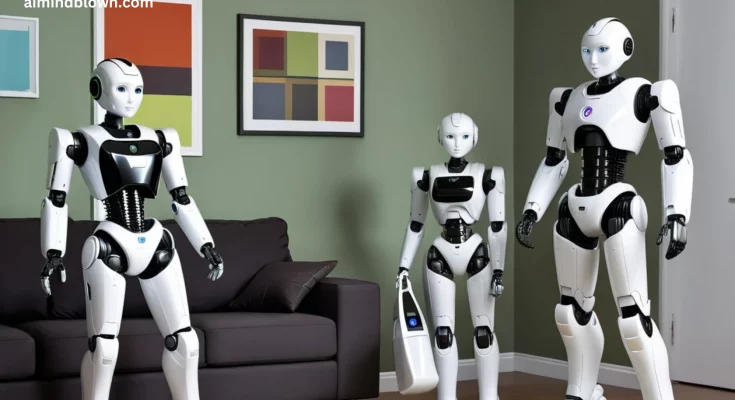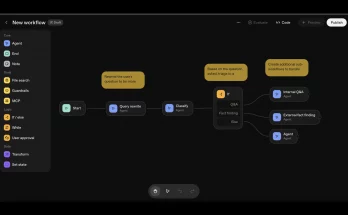The Future of Household Chores
In recent developments, the dream of having robots perform household chores is inching closer to reality. With advances in artificial intelligence (AI) and robotics, companies like Figure are making significant strides towards creating humanoid robots capable of understanding and executing complex tasks. This article delves into the advancements made by Figure and highlights the competitive landscape surrounding AI-powered domestic robots.
Introducing Figure and Its Breakthrough
Last week, Figure, a robotics startup backed by OpenAI, showcased humanoid robots equipped with advanced capabilities. These robots can understand voice commands and recognize previously unseen objects, making them increasingly adaptable in dynamic environments.
For instance, in a recent demonstration:
- A person unloaded groceries, including eggs, an apple, ketchup, cheese, and cookies.
- Upon receiving verbal instructions, the robots efficiently sorted each item — placing perishables like eggs and cheese in the fridge, cookies in a drawer, and the apple on the counter.
Figure claims to be the first company to enable two robots to collaborate on household tasks, a significant milestone in robotics innovation. Their robots are powered by Helix, a generalist AI model that effectively combines vision, language understanding, and movement control. This integration addresses the unique challenges posed by homes, where objects vary unpredictably.
Helix: Making Robots Smarter
Figure developed Helix in-house, tailoring it specifically for the complexities of household tasks. While they initially utilized OpenAI’s AI models, they pivoted to develop their own technology after achieving a breakthrough. As a result, Helix equips robots with enhanced reasoning abilities, enabling them to determine where items belong, based on context and functionality.
Potential Impact of Investment
Amidst these exciting advancements, reports indicate that Figure is in discussions to raise $1.5 billion in its latest funding round. Should this funding come to fruition, it would elevate the company’s valuation to approximately $39.5 billion. This investment would not only accelerate the development of residential robots but also aid in the creation of devices for commercial applications.
The Competitive Landscape of Robotics AI
Despite Figure’s innovations, the market for robotics AI is becoming increasingly competitive. Major tech players are also joining the race to develop humanoid robots capable of managing daily tasks.
Meta’s New Robotics Team
Meta, known for its investments in virtual reality, is reportedly forming a dedicated team within its Reality Labs division. This team will focus on developing AI-powered humanoid robots for household chores and creating relevant technologies that cater to various companies in the robotics sector.
Google’s Apptronik
Another contender, Apptronik, recently raised $350 million in a Series A funding round and is focusing on the deployment of its humanoid robot, Apollo. This robot aims to leverage AI and collaborate with the Google DeepMind robotics team to enhance its functionality in real-world applications.
Tesla’s Ambitious Plans
Not to be outdone, Tesla is also stepping into the humanoid robotics space with its production of the Optimus robot. CEO Elon Musk announced plans to manufacture several thousand Optimus units within the year, targeting diverse utility applications.
Musk emphasized the need to design everything from the ground up, stating, “Nothing worked for our humanoid robots, at any price.” The ambitious goal is to deliver robots at an affordable price of less than $20,000 once production ramps up to over a million annually.
Challenges Facing Humanoid Robots
While the prospect of robotic helpers is enticing, challenges loom large, particularly regarding their efficiency in household environments. According to Jenny Shern, general manager at NexCOBOT, humanoid robots encounter more complex obstacles compared to their industrial counterparts.
- Households are highly dynamic, presenting varied tasks in unpredictable settings.
- Preprogrammed instructions serve well in repetitive factory environments but falter in domestic scenarios where tasks vary significantly.
As Shern explains, effective AI integration is crucial for interpretation of human commands and generating task-specific actions. For example, a robot tasked with “cleaning up the table” must comprehend the context, recognize items, and decide actions like sorting perishables or disposing of waste.
The Path Forward
Rodney Brooks, co-founder and CTO of Robust AI, also voiced skepticism about the current capabilities of these humanoid robots. In a recent discussion, he highlighted the disparity between human and robotic efficiency, noting that humans can perform tasks at a substantially faster pace.
Ultimately, Brooks emphasizes that it will take considerable advancements — both technological and design-based — for humanoid robots to offer a cost-effective, scalable solution that businesses and consumers alike will find beneficial.
Conclusion: The Road Ahead for Robotics AI
The advancement of AI-powered robots, exemplified by Figure and its competitors, showcases the potential for significant changes in the way household tasks are approached. As robotics technology continues to evolve, consumers may soon enjoy the luxury of AI helpers performing daily chores.
While challenges remain in the path of creating efficient, adaptable household robots, innovative solutions and collaborative efforts are paving the way toward a future where AI-powered robots can seamlessly integrate into our lives, transforming the household chores landscape forever.



